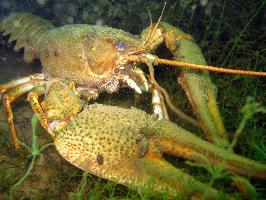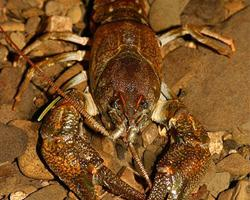
Greutăți și măsuri
| Lungime | de la 15 la 30 cm |
|---|---|
| Greutate | 200 g |
Starea de conservare
| Amenințat |
Descrierea animalului
The Danube crayfish (Astacus leptodactylus), also known as the narrow-clawed crayfish, is a fascinating species of freshwater crayfish indigenous to Eastern Europe and parts of Western Asia. This species is named after the Danube River, a significant habitat for these crustaceans, but its distribution extends across various freshwater bodies from the Balkans to the basins of the Volga and Ural Rivers.Astacus leptodactylus is characterized by its slender claws, from which its scientific name, 'leptodactylus' meaning 'slender-fingered', is derived. These crayfish can reach a substantial size, with adults typically measuring between 10 to 20 centimeters in length, although some specimens have been known to exceed this range. Their body is segmented and covered in a robust exoskeleton that provides protection against predators. The exoskeleton can vary in color, from shades of green to brown, helping the crayfish blend into its surroundings and evade predators.
The Danube crayfish is a nocturnal creature, spending much of its day hidden under rocks, in burrows, or amongst vegetation to avoid predators. Its diet is omnivorous, consisting of plant matter, detritus, insects, and small fish, which it catches using its powerful claws. These claws are not only tools for feeding but also serve as a primary means of defense against threats.
Reproduction in Astacus leptodactylus occurs once a year, with the female carrying the fertilized eggs attached to her swimmerets under her tail. The number of eggs varies depending on the size of the female but can range from a few dozen to several hundred. After hatching, the young crayfish remain under the mother's protection for several weeks before becoming independent.
The Danube crayfish plays a significant role in its ecosystem, contributing to the nutrient cycle and serving as both predator and prey within its food web. However, like many freshwater species, it faces threats from habitat destruction, pollution, and particularly the introduction of non-native crayfish species. These invasive species can outcompete native crayfish for resources and are often carriers of crayfish plague (Aphanomyces astaci), a deadly disease to which the Danube crayfish is highly susceptible.
Conservation efforts are crucial to protect the Danube crayfish and its habitat. Measures include monitoring and controlling the spread of invasive species, habitat restoration, and enforcing regulations on water quality and waste management. Through these efforts, there is hope that the populations of Astacus leptodactylus can be preserved for future generations to admire and study.
Animale similare
Fotografii noi cu animale
Top 10 animale
- Dolphin gull (Leucophaeus scoresbii)
- Diana monkey (Cercopithecus diana)
- Moustached guenon (Cercopithecus cephus)
- Galápagos tortoise (Geochelone nigra complex)
- Stone loach (Barbatula barbatula)
- Japanese macaque (Macaca fuscata)
- Greek tortoise (Testudo graeca)
- Russian tortoise (Testudo horsfieldii)
- Common flying dragon (Draco volans)
- Galápagos penguin (Spheniscus mendiculus)


